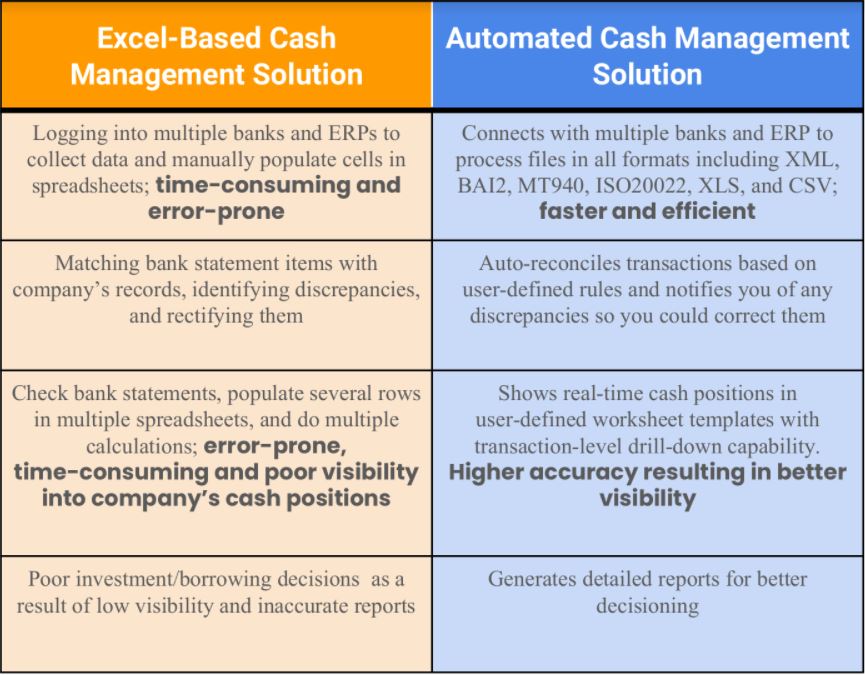How an Automated Cash Management Solution Solves The Daily Problems of a Cash Manager
Dealing with a large number of transactions can be tedious, time-consuming, and error-prone. Learn how to make this procedure more efficient by automating it.
Why is cash management important?
The day-to-day monitoring of cash inflows and outflows in a company is referred to as cash management. On a daily basis, businesses have a massive quantity of cash inflows and outflows that must be carefully handled in order to meet payment obligations, prepare for future payments, and maintain enough corporate stability and visibility.
No room for any surprises
The primary goal of cash management is to keep track of how much money you have at the end of the day. This level of visibility allows you to set a specific target for each bank account so you’ll always have cash on hand if you find yourself in a pinch. Moreover, having visibility over your balances aids in avoiding a cash crunch situation and if it comes to it, prevents your company from going bankrupt.
Unnecessary bank fees can be avoided
Every time you request access to your bank records, you will be charged a fee. By having a robust cash management solution, you’ll have your own set of records and won’t have to run to the bank every time you want to investigate a certain transaction from the past records.
You’ll always know when to invest or borrow
Cash management aids in better visibility over account balances, which in turn allows cash managers to evaluate whether there is any surplus cash to invest in order to keep idle funds fully employed. Similarly, if there is a requirement, you will be aware of it so that arrangements can be made in advance to borrow money. Additionally, you would know if any of your other branches have spare funds and if you could borrow money from them rather than relying on external sources. Companies could avoid paying exorbitant borrowing rates this way.
How do companies manage their cash?
As businesses grow, so do their cash flow volumes, and managing them isn’t easy. Large companies often have a lot of cash flow data, which makes it difficult for treasurers to manage their cash, especially with manual methods like spreadsheets. The day starts with logging into multiple bank portals, retrieving bank statements every day, and manually matching items from bank statements with spreadsheet records. While this has long been a popular method of managing cash, it does come with its own set of challenges.
Highly manual and time-consuming process
Cash managers spend nearly 15 hours per week reconciling bank statement items with their company’s books. Not to mention, the hassle of logging into several bank portals to collect bank statements for hundreds of bank accounts across the firm and populating multiple spreadsheets with the data. The method is not only time-consuming and error-prone, but it also requires a lot of labor. One of the many other headaches associated with the process is going back and identifying
discrepancies and rectifying them.
Low visibility into your company’s finances
Browsing through several spreadsheets and updating the cash positions of each and every bank account is no walk in the park. To get the final end-of-day cash positions of each and every account, a cash manager must check the statements, populate several rows in multiple spreadsheets, and do multiple calculations. Because everything has to be finished manually before the end of the day, you’d be surprised how often a cash analyst or manager misses a few details while analyzing your company’s cash flows.
Poor reporting results in bad investment decisions
As a consequence of the previous steps, more often than not the reports generated are incorrect. Taking intercompany loans instead of seeking funding from external sources can save you up to 30% in interest fees. Despite this, Treasurers end up making wrong decisions and wasting thousands of dollars by paying exorbitant interest rates due to poor visibility over their company’s cash positions.
Benefits of leveraging automation to optimize cash management
Businesses have largely shifted to a more technologically driven approach to Treasury in recent years. It not only saves time by eliminating day-to-day repetitive tasks in cash management, but it also reduces the possibility of error and makes the process more efficient by allowing cash managers to devote their time to higher-value tasks such as decision-making.
Here’s how an automated cash management solution would look like.
Easy integration with multiple data sources via APIs and sFTP
You no longer need to manually fetch data from portals because the HighRadius Cash Management Cloud connects seamlessly with all banks, ERPs, and independent market data sources to process files in all formats including XML, BAI2, MT940, ISO20022, XLS, and CSV. You can auto-classify transactions based on bank, account, region, and category and view them in customizable templates. It also allows you to override or manually upload additional data as required.
Automated matching of previous day records with bank statement items
The solution auto-reconciles transactions based on standard and user-defined rules without the need for any manual intervention. It also allows you to manually match or rectify any discrepancies. Automated bank statement processing and reconciliation saves time, reduces errors, and frees up cash managers to focus on other higher-value tasks.
Better visibility into company’s cash
No more skimming through multiple spreadsheets to get a view of company-wide finances because now you can check real-time cash positions across bank accounts, companies, pools, and currencies in user-defined worksheet templates with transaction-level drill-down capability. Based on this information, the HighRadius Cash Management Cloud creates recommendations for concentration and funding transfers.
Richer reporting
Better visibility contributes to better reporting and, as a result, better decision-making. Now that you have an idea of intercompany activities and where your cash is, you can figure out if you have any surplus cash lying around and the accounts that might need funding. As a result, you won’t have to borrow money from vultures on the street.

